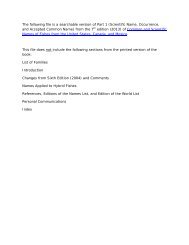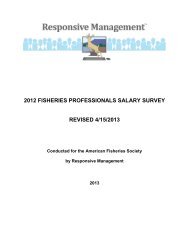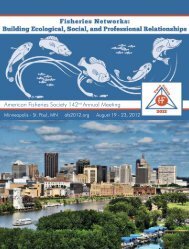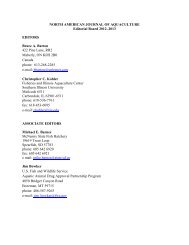Conservation Status of Crayfish Species Paddlefish Conservation ...
Conservation Status of Crayfish Species Paddlefish Conservation ...
Conservation Status of Crayfish Species Paddlefish Conservation ...
You also want an ePaper? Increase the reach of your titles
YUMPU automatically turns print PDFs into web optimized ePapers that Google loves.
were present, as well as representatives from<br />
various sport fishing and conservation groups.<br />
One common theme among proponents <strong>of</strong><br />
opening up new waters was that removing<br />
rough fish is good for sport fish. Opponents<br />
opined that (1) the interests and economic<br />
impact <strong>of</strong> sport anglers in those reservoirs<br />
dwarfed the benefits that might be accrued by<br />
a handful <strong>of</strong> commercial fishers, and (2) those<br />
waters were too crowded with recreational<br />
boaters to permit widespread deployment <strong>of</strong><br />
gill nets. The commissioners subsequently<br />
opted to keep the commercial fishing ban in<br />
effect in the upper Tennessee River and not<br />
open additional waters.<br />
Following the July 2005 TWRC meeting,<br />
all (n = 112) fishers holding a free paddlefish<br />
permit were invited to attend a facilitated<br />
meeting in Nashville in August 2005. (Note:<br />
Beginning in March 2006, paddlefish and<br />
sturgeon permits previously issued by TWRA<br />
at no charge were replaced with a roe fish permit<br />
costing US$1,000 and the fee for a commercial<br />
fishing license was increased from<br />
US$125 to US$200; fishers were required to<br />
purchase a roe fish permit and commercial<br />
fishing license if they wanted to harvest paddlefish<br />
or shovelnose sturgeon Scaphirhynchus<br />
platyrhynchus.). Forty-two fishers attended<br />
and they were instructed (in their invitation<br />
letters) to choose seven <strong>of</strong> their peers to represent<br />
their views. The purpose <strong>of</strong> the meeting<br />
was to obtain the opinions <strong>of</strong> fishers on the<br />
proposed regulation changes (Table 1), but<br />
in a more structured environment than the<br />
open public meetings. The panel was seated<br />
and the facilitator (the personnel director <strong>of</strong><br />
the TWRA) explained the rules <strong>of</strong> the meeting.<br />
Fishers not on the panel would not be<br />
allowed to speak until the panel addressed<br />
each regulation.<br />
despite the best efforts <strong>of</strong> the facilitator,<br />
panelists did not limit their comments to each<br />
regulation as each was considered. When the<br />
“no fishing refuge” recommendation was presented<br />
for discussion, few comments were<br />
directed at the idea <strong>of</strong> a refuge itself. Most<br />
fishers eventually agreed that it would not<br />
be a burden. After about an hour, the panel<br />
agreed to consider the next regulation.<br />
Limited entry was not recommended in<br />
the final report but the TWRA included that<br />
option in their list <strong>of</strong> recommendations. That<br />
is, TWRA would be willing to limit the number<br />
<strong>of</strong> new roe fish permit holders to some percentage<br />
above the number that purchased this<br />
new permit before the end <strong>of</strong> the 2005–2006<br />
fishing season. The panel was unanimously in<br />
favor <strong>of</strong> limited entry, which clearly benefited<br />
them and their colleagues.<br />
The discussion on shortening the season<br />
was brief. TWRA staff indicated at the July<br />
2005 TWRC meeting that they wanted to<br />
close the season on 31 March. The final report<br />
recommended moving the end <strong>of</strong> the season<br />
from 23 April to 7 April. A comment to “split<br />
the difference” between 7 April and 23 April<br />
(i.e., April 15) was met with approval by the<br />
full panel <strong>of</strong> seven commercial fishers. The<br />
brevity <strong>of</strong> their comments was surprising, considering<br />
how important season length was to<br />
their ability to make a living.<br />
The ban on mon<strong>of</strong>ilament netting met<br />
with opposition from some fishers, particularly<br />
those fishing the Mississippi River. Many<br />
fishers prefer mon<strong>of</strong>ilament netting because it<br />
snags less debris (e.g., filamentous algae and<br />
other detritus) and shakes clean easier than<br />
multifilament netting.<br />
The subsequent recommendation that<br />
fishers be prohibited from “blocking” paddlefish<br />
onboard their boats met with strong<br />
opposition. Removing the head, tail, and fins<br />
was commonplace, but this made the use <strong>of</strong><br />
a minimum length limit (the next item up<br />
on the agenda) problematic. In the past, a<br />
fisher could keep an intact paddlefish longer<br />
than the minimum EFL limit, or a blocked<br />
carcass longer than a length calculated by<br />
TWRA <strong>of</strong>ficials to represent the minimum<br />
EFL length limit. For instance, when the<br />
minimum length limit was 864-mm (34”)<br />
EFL, the blocked carcass had to be at least<br />
635-mm (25”) long. Allowing fishers to use<br />
either approach had long troubled TWRA<br />
enforcement <strong>of</strong>ficers because <strong>of</strong> the potential<br />
<strong>of</strong> fish being blocked in such a way as to make<br />
an illegal fish legal.<br />
The discussion concerning blocking fish<br />
was followed by strong opposition to increasing<br />
the length limit from 864-mm EFL to<br />
965-mm EFL over four years, with the option<br />
<strong>of</strong> going to a 1,016-mm EFL limit if the population<br />
did not show signs <strong>of</strong> recovering from<br />
overfishing. The panel generally agreed that<br />
a 914-mm length limit could be tolerated, but<br />
a 965-mm length limit would hurt business<br />
too much; raising the minimum size to over<br />
1,000-mm EFL was totally unacceptable. The<br />
floor was subsequently open to comments<br />
from all fishers in attendance. Most comments<br />
revisited topics that had earlier been<br />
taken <strong>of</strong>f the table (e.g., opening new waters<br />
to commercial paddlefish harvest; stocking<br />
fingerlings to mitigate for overfishing).<br />
A regularly scheduled TWRC meeting<br />
in Knoxville in September 2005 followed<br />
the August 2005 “invitation only” facilitated<br />
meeting. This was the “Proclamation<br />
Meeting” at which new paddlefish regulations<br />
would be voted on by the commission.<br />
As chief <strong>of</strong> fisheries, the third author listed<br />
each proposed regulation change that the<br />
TWRA fisheries staff had crafted after considering<br />
three months <strong>of</strong> public meetings and<br />
comments; the audience was then allowed to<br />
speak to each proposed change. The TWRC<br />
received few complaints from the audience<br />
when they voted to establish the proposed<br />
refuge. In fact, when one commissioner<br />
questioned whether a refuge was necessary, a<br />
commercial fisher spoke up and defended the<br />
concept <strong>of</strong> a refuge.<br />
The stepwise increase in the length limit<br />
(immediately raise the length limit from 864<br />
to 914-mm EFL, then raise it to 965-mm EFL<br />
over a three-year period) was not debated<br />
on its merits by four fishers who opposed<br />
that change. For instance, the <strong>of</strong>t-repeated<br />
claim came up again that the researchers did<br />
not know what they were doing until they<br />
(the commercial fishers) helped them (the<br />
researchers) catch fish. The TWRC was not<br />
swayed by those arguments against the mini-<br />
table 1. potential regulations presented for discussion by a Tennessee Wildlife Resources Agency facilitator to a panel <strong>of</strong> seven representatives <strong>of</strong> the commercial<br />
paddlefish fishing industry at a facilitated meeting in Nashville, Tennessee, August 2005. Another 35 fishers were in attendance.<br />
regulation rationale/justification<br />
establish a no-fishing refuge Reduce bycatch rates and mortality by reducing encounters between juvenile paddlefish and gillnets.<br />
limited entry prevent the number <strong>of</strong> fishers targeting paddlefish from increasing with ever-increasing roe prices.<br />
Shorten Season Reduce harvest and prevent fishing when high water temperatures will cause high bycatch mortality.<br />
Ban mon<strong>of</strong>ilament nets Reduce bycatch mortality.<br />
prohibit the blocking 1 <strong>of</strong> carcasses onboard Improve the ability to enforce minimum length regulations.<br />
Increase the minimum length limit Reduce growth overfishing and eliminate concerns over recruitment overfishing.<br />
1 Removing the head, tail, fins, and viscera to facilitate storage and chilling <strong>of</strong> the carcass.<br />
394 Fisheries • vol 32 no 8 • august 2007 • www.fisheries.org







